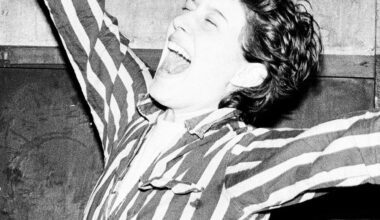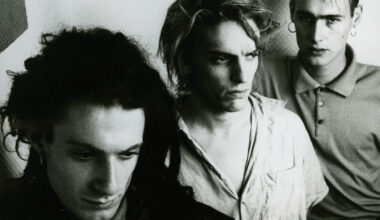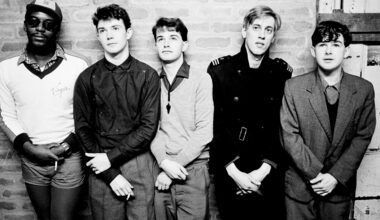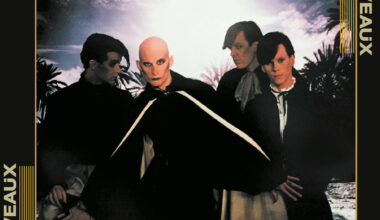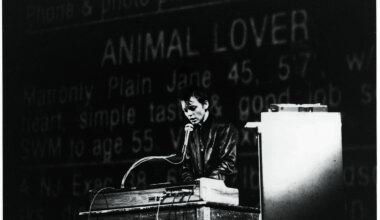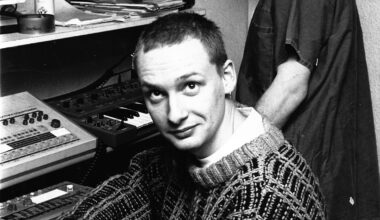Ron Wright, from Sheffield’s second-wave industrial funkers Hula, talks us through the making of the 1986 Steel Town electro showstopper, ‘Freeze Out’

As a boy, you want to be a train driver, then a footballer, then a musician. I’d never thought about being in a band and I’m not really a musician, but I played guitar in Hula because I didn’t want a guitarist strumming all the way through – I just wanted little bits. That was quite important, because if I was a good guitarist I’d want to show everyone that I was good.
The recording Walkman and the VHS recorder really democratised music, because suddenly you could record things to tape from TV documentaries, or the street, or objects, or just sounds. You were basically recycling them through your music.
Hula weren’t very accessible because we included things like that in ur tracks. What we were trying to do was create something that we’d love to go and see and listen to, and because we weren’t really good musicians, we came at it from a more experimental angle.
We also lacked a producer, and so what we did was quite chaotic. We were really good live – we’d use loads of TV monitors and computerised slideshows. We didn’t want lights on us with the colours changing when we hit a different chord. We kind of played in the dark, really.
‘Freeze Out’ was created live. It was never actually recorded as part of a batch of songs for an album. The way we used to work was from a rhythmic base, constructing rhythms from loops or drums machines and then we’d add an element of live drums on top. Nort, our drummer, was a really good programmer. We were very into making loops, and they were very often not of rhythms, but they’d become rhythmic. Also, prior to samplers, we did a lot of processing.
We were always trying to be experimental, but were also listening to quite a lot of new music – there was a lot of dance music of different sorts coming from the States, and we were listening to electro, funk and a lot of black music. The dance scene in Sheffield was really kicking off at that time, so there was a real connection between that and America. We were absorbing all of it, and because of that influence the main loop for ‘Freeze Out’ was based on an electro rhythm.
The version of ‘Freeze Out’ that was released as the A-side of the single was recorded in session for the VPRO radio station in the Netherlands in February 1985. VPRO were really supportive of Hula. One day we got a phone call from a guy called Richard Zeilstra, who was the Dutch equivalent of John Peel. He had a programme called ‘Frontline’ and he said, ‘I want you to come over and do four tracks, but I’ve got one condition – you cannot prepare the tracks in any way. You’ve got to start from scratch in the studio.’
We went to their VARA studio in Hilversum. It was this amazing studio where they recorded the National Orchestra. Richard had got this engineer in, Bert Vervoorn, who was used to doing classical music. He was a lovely guy, but he hadn’t really moved much outside of classical music. We kind of had a rough outline for ‘Freeze Out’ before we went, and for the first two days we were cutting loops and recording bits of sound onto 24-track tape.
Bert was splicing and cutting this stuff together, and toward the end of the second day he said, ‘When are you actually going to do any music?’. We were like, ‘Don’t worry about it, this is the process’. And then he totally got into it. Something clicked with him, and by the end he was just wanting to do loops, when we were sitting there going, ‘What shall we do now?’. He was like, ‘Oh, what about a loop?’. ‘Freeze Out’ was basically a loop with drums on top. It was just bashed out on guitar, drums, bass, keyboards, with some weird noises being thrown in.
Some of my lyrics on ‘Freeze Out’ were about the miners’ strike, but people won’t necessarily know that, because my vocals always tended to be little layers of almost stream-of-consciousness ideas. The miners’ strike was quite a big thing for me, and it was quite a big thing in Sheffield as well. It was the death of traditional industry, and that still resonates with me today.
I’ve never thought I could sing, but I was the one who had the echo unit, so I sang in Hula. It’s a bit like with football where the kid who owns the ball takes the penalty. I had an Echoplex tape echo machine, which did something called sound-on-sound so the voice would go round on a loop but you’d build onto it and onto it so it would just become textural, but of course it had no synchronisation to whatever was being played, and I was quite into that.
We also recorded a session version of ‘Freeze Out’ for John Peel at Maida Vale, which appeared on the B-side of the 12-inch. Mike Robinson produced that, but the producers of Peel Sessions generally kept out of the way and you just did your tracks live. On the version of ‘Freeze Out’ for John Peel, there’s kind of a mashed-up violin sound that we’d processed and fed in. About 10 minutes before the end of our session recording time, we’d only done three tracks and they wanted four, so we put some drones down and threw percussion instruments around. Mike Robinson had been in the pub and he came back to lock up. He came in and we were throwing things around, and he was like, ‘Ooh, this is interesting’. He loved it. It was quite funny.
Remastered reissues of Hula’s back catalogue are available via Klanggalerie.
